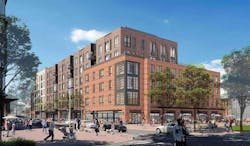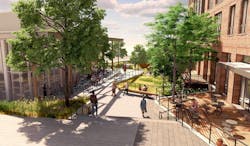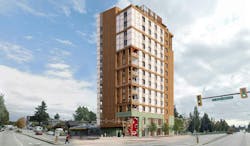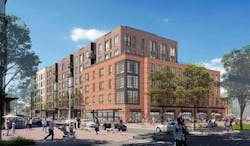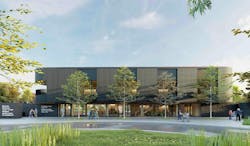8 strategies for multifamily passive house design projects
It’s official: passive house design standards are coming to Massachusetts. The lessons learned in the Northeast can help design energy-efficient, multifamily buildings elsewhere too.
The Commonwealth of Massachusetts rolled out ambitious updates to its Building Energy Code in 2023. The new Specialized Opt-In will require passive house certification for all multifamily buildings larger than 12,000 sf. It also makes passive house one of the available compliance pathways for all other building types. Beginning in 2024, communities that have opted in must design and build multifamily buildings to passive house standards.
The change is substantial. With the right approach, passive house strategies can help our clients serve their market, while leading us to efficient, healthy, and resilient multifamily dwellings.
When completed, Northland Newton Development project will be one of the largest all-electric, market-rate passive house projects in the world. It is a 22.7-acre semi-urban, mixed-use redevelopment. At Northland Newton Development, our team designed four residential passive house buildings within a larger complex. We are excited to help our progressive and ambitious client to target Passive House International certification. Back in 2018, our client saw passive house design strategies as the ideal way to achieve their own long-term goals for resiliency, energy efficiency, and high-quality building standards.
By embracing an early adopter ethos, Northland Newton Development will enter the market ahead of the regulatory curve, with valuable gained experience. With our experience designing for passive house standards on this and other project, we’ve seen which design approaches contribute to passive house success.
Passive House Design Principles
First, a quick explanation of passive house. Developed in Europe, passive house is a rigorous approach to design and construction that focuses on five major aspects of building energy use.
- Super insulated envelopes
- Airtight construction
- High-performance glazing/windows
- Thermal-bridge free detailing
- Heat recovery ventilation
Simply put, a passive house approach creates a hyper-efficient building. It allows designers to use smaller, more efficient heating and cooling systems to keep occupants comfortable. That’s a win-win!
8 Multifamily Passive House Design Strategies
Here are eight passive house design strategies we find useful when designing multifamily residential projects:
1. Orientation matters
In a passive house design approach, the building’s relationship with the sun is key.
Passive house strategies seek to minimize heat gain in summer and maximize it in winter. Thus, site selection, site orientation, climate zone, and building orientation are key on passive house projects. We can iterate massing options early in design and evaluate each for solar gain potential.
2. Look for energy—everywhere
The passive house designer’s goal is to use as little energy as possible. It’s not only about the air conditioning or heating. It’s also the lights, appliances, hot water, windows, balcony doors, and anything else that uses energy or affects heating and cooling demands. In a multifamily building, items like a refrigerator or the amount of hot water piping that service the bathroom add up quickly.
For example, 10 feet of hot water piping per unit in a 500-unit building results in 5,000 feet of hot water piping in the building. In passive house design, we calculate the piping distance and volume from the hot water source to the end use fixture. If we shorten the distance the hot running water takes in each unit, we can see substantial energy savings at the building scale. On Northland Newton Development, we found that if we cluster bathrooms closer to the mechanical closet in the units and shorten the pipe servicing them, we reduce the building’s energy appetite.
3. Run models often
Designing for passive house standards requires the team to utilize energy modeling regularly. Our team runs models like THERM. It calculates the two-dimensional heat-transfer effects in building components such as windows, walls, foundations, roofs, and doors.
By building this modeling time into the early design process, we maximize its impact. The knowledge these models provide us is critical to reducing energy use and thermal bridges.
4. Dig into the details
The smallest details can be extremely important to energy efficiency. With Northland Newton Development, for example, we supported the brick cladding off steel relieving angles, which is common. The usual way to connect these steel relieving angles to the building’s superstructure creates a “thermal bridge.”
A thermal bridge acts as a conductor between the building and the environment. It would radiate cold from the outside to the inside in winter. Passive house seeks to eliminate thermal bridges, so we had to innovate. In response, we employed a strategy that connects the angles with a layer of nonconductive rubber to remove the thermal bridge.
5. Collaboration is key
Collaboration is foundational to our integrated design practice. To deliver a building at the elevated standards of passive house certification, we must engage in deep cross team collaboration.
For Northland Newton Development project, we had to test to see if critical details—like the thermally broken relieving angle mentioned above (not yet common practice in construction in our region)—would be effective. So, we worked together with our structural engineer, sustainability consultants, and contractor to confirm the detail would satisfy the structural requirements and work in the field. With input from the mason, we devised a bolted version of the detail to allow for adjustments in the field. This resulted in a relieving angle that our team is secure can be executed in construction while maintaining the thermal break. Getting these details right is essential to certification. A passive house verifier will inspect and confirm the construction in the field meets the requirements of the standard.
6. Say yes to windows (and save energy elsewhere)
Reducing window sizes is one route designers often take when trying to reach the passive house building envelope standard. But for many multifamily clients, this approach doesn’t meet market expectations for access to natural light. We had to find a way to achieve attractive window-to-wall ratios and maintain a highly efficient envelope.
We looked to window manufacturers in the US and Europe to see who could push efficiency higher. On this project, rather than import from Europe, we discovered highly efficient windows made in Kansas met our needs. These triple-glazed windows cost more. But they allow us to meet passive house standards, provide increased thermal comfort, have better acoustic properties to decrease outside noise, and they have the potential to pay for themselves over time in energy savings. We also looked for energy efficiency trade-offs. If you want larger windows in a passive house building, you need to find ways to be more aggressive on energy savings.
What did we do? We looked at increasing efficiency in the building’s light and power density, appliances, hot water heaters, air handling, and heating and cooling. We found by spending some additional time fine-tuning the mechanical system with our engineers and consultants we were able to increase the building’s efficiency. This extra effort helped offset the impact of the additional glazing.
To sum it up, passive house dwellings need not be solid and closed-off. They can be elegant and welcome natural light. One of the advantages of passive house is that it’s not prescriptive, so it gives us room to innovate or find efficiencies to meet its goals.
7. Insulation matters
A well-insulated building is basic to the passive house approach. But as we have learned, it’s not as clear cut as just adding more insulation to the walls and roof. Every aspect of insulation matters. For the envelope to be truly effective, the design must wrap the entire building and maintain insulation at the critical junctures between floor and wall and at unique intersections at balconies, canopies, and overhangs. The details matter. Passive house compliance simply pushes us to pay extra attention to these details. For our designs to be certified we must be able to show that the thermal and air barriers are maintained at all locations.
At Northland Newton Development, we found we did not have to increase the insulation values in our walls and roofs significantly. But we needed to be more intentional about maintaining our thermal envelope at every detail. We prefer to use mineral wool as insulation whenever we can because it is a resilient and environmentally friendly material. On this project, we were able to minimize use of spray foam and use a combination of mineral wool and fiberglass batt on most of the envelope.
8. Get excited, maintain heightened awareness
On Northland Newton Development, we went on a journey with an engaged and ambitious client. We rallied our team, our consultants, and construction team around the cause. We came out the other side of the passive house process stronger and wiser from the experience.
Everyone involved was transformed into believers in passive house as a great way to design buildings. This passive house experience heightened our awareness of the elements, details, and approaches that make an extremely efficient building work at the multifamily residential scale.
We are taking this deepened experience forward. We are applying it wherever we can. By 2024, passive house will be the only path available for designing multifamily projects in many places in Massachusetts, and we expect this trend to join others and expand across the industry.
Now is the time to embrace it.
